Men at at Hizb ut-Tahrir Britain rally in Hyde Park in 2004
It was back in 2004 that I first came across Hizb ut-Tahrir Britain, which I described then as “an independent Islamic political party dedicated to re-establishing the Islamic way of life under an Islamic caliphate (Khilifah.) The repetition of the word ‘Islamic’ was of course deliberate and intended to mirror the relentess and repetitive approach of the speeches and the visual effect, with its large banners, black characters on intense orange.
Hizb ut-Tahrir march against ‘Busharraf’, 2004
There were very few journalists and photographers at that event, and I remember talking to one of them, a man who had been researching and following the movement for some time and who considered it to be a dangerous and influential fundamentalist movement which governments would be wise to proscribe.
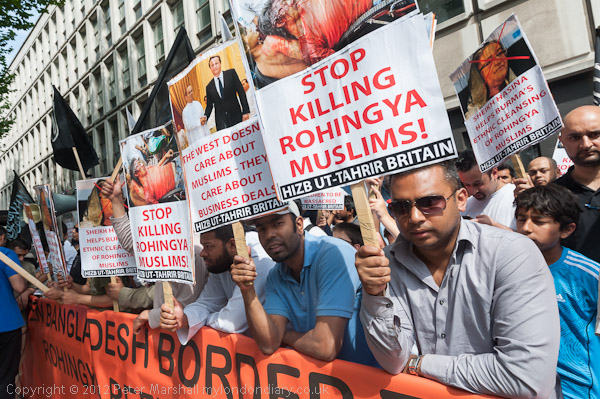
Protest opposite Bangladesh High Commission supporting Rohingya, 2012
There have I think been a few minor changes over the past 8 years, at least presentationally, although the protests still look much the same, but I think the speakers are a little less strident (though I only understand those who speak in English) and some have been careful to point out that they are not aiming at the overthrow and replacement of the British state and that their ambition is for the Khilfah to replace the current corrupt and largely dictatorial rulers of the Muslim states. Although their removal seems an excellent idea, I’m certainly not convinced that I would want to live under the rule of Hizb ut-Tahrir, and I still find some aspects of their protests unsettling.
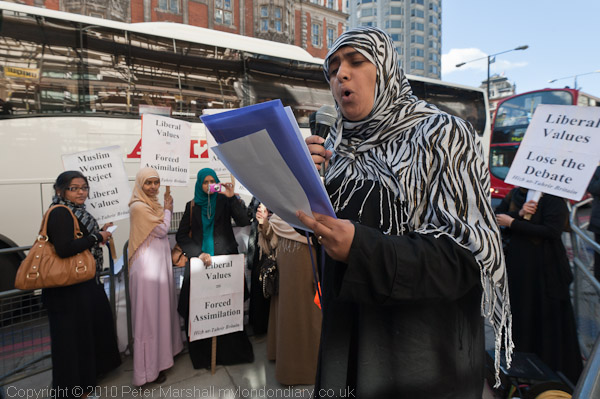
One of a number of women speaking as Hizb ut-Tahrir women protested the French veil ban, 2010
One is the separation between men and women at their protests; it isn’t the actual segregation I find so disturbing but that women seem often to be treated as second-class citizens, off to one side of where the real action (in this case the speeches and the loudspeakers relaying them) was taking place, with none of the speakers being women. Many of them were so far away along the road that they could not see or even hear properly what was going on. The only time I’ve seen the women of Hizb ut-Tahir ever fully taking part in a protest was at a ‘women only’ protest over the French ban on Islamic face veils.
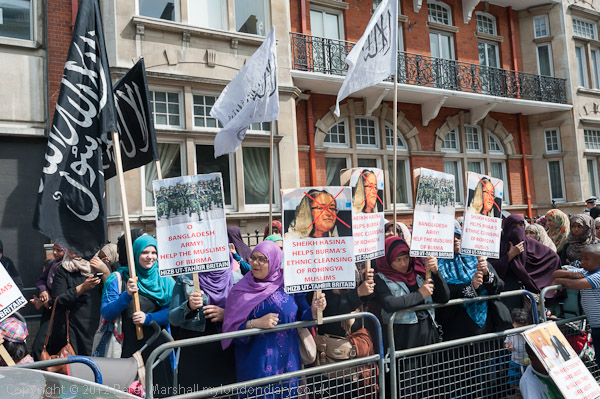
Women protest separately at one side of the protest in support of Rohingya, 2012
The protest on 11th August was at the Bangladeshi High Commission in a wide and fairly empty street in Kensington, not far from the Natural History Museum and the Albert Hall. Although some of their protests over the years have attracted the attention of many photographers, again this was not one of them, and when I arrived a few minutes after the time the protest was to start, I seemed to be almost the only journalist or photographer present other than the organisation’s own people (and of course many in the protest were taking pictures with their phones.)
I like to get to events on time, if not at least a few minutes early. Often the most interesting situations happen as people are arriving and things are being set up, though I also generally stay on as long as I can. Years ago, when I first went to photograph a number of carnivals with a few friends, I was surprised that as soon as the actual procession started they would put their cameras away and go to the pub, but usually they were right, many events are essentially over for the photographer once they have started. Others – and perhaps this protest was one – never really begin.
My lateness was simply a result of London traffic and my decision to take a bus to the protest. Buses are my favourite method of travel around London, giving a great view of the city from the upper deck, but like cars and taxis they are unreliable. On this occasion I’d had far too long to enjoy the view of Fulham Broadway on my way to Kensington.
The only really reliable way to get around London is on a bike, or for shorter distances, feet. But I don’t like taking my bike to protests, as finding a good place to use my heavyweight lock can be difficult, and even the best locks only deter the more casual thieves and don’t protect against vandalism. They are also a nuisance with marches, when you have to go back to the start to collect them. But had I thought, I would have ridden to this static protest in a posh area on a sunny day when traffic was likely to be bad, especially with various large sporting events in the city. But I’m getting old and lazy and have a free bus pass I like to use!
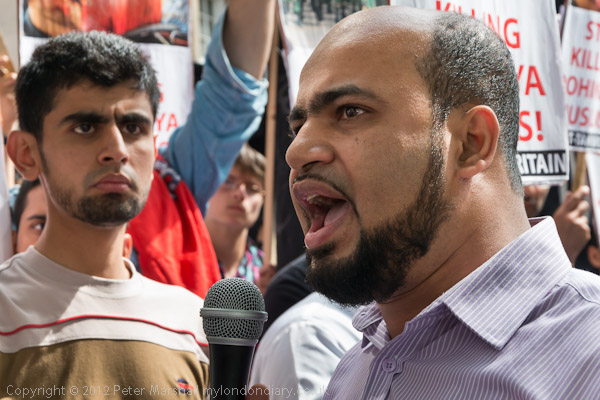
Hizb ut-Tahrir Supports Rohingya, 2012
The still photograph can’t convey the actual words that people say, but it can show something of the mood and I concentrate on the expressions and gestures of the protesters and in particular the speakers. Words and images may come from placards and banners, which are also very important in photographing protests.
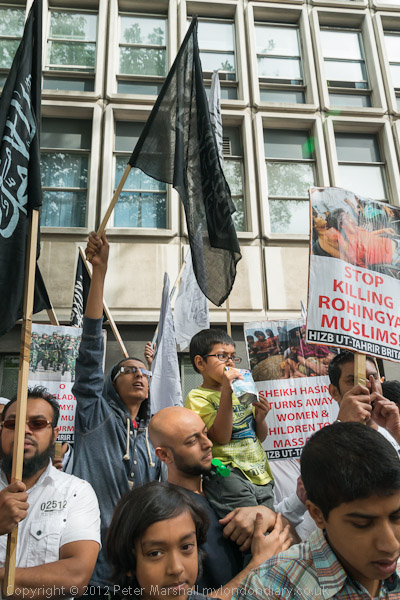
Hizb ut-Tahrir Supports Rohingya, 2012
Photographers are very attracted by sounds at protests, whether those of people chanting, shouting or speaking or (absent from this event) music or drumming etc. If you are working with video, the sounds are often the most important part of the event, but as a still photographer you need to keep reminding yourself that they don’t record in your images. You have to work to try and catch the feeling of the moment. It’s a start to be seeing and hearing the excitement – it suggests you are somewhere near the right place – but you have to work hard to make it show in your images.
Of course it’s important to be honest about the event you are photographing, while obviously your photographs will also present your own point of view. I’m often unhappy about the way that single images are used in the press which often give a very distorted view of events, and I’m far happier presenting my own work through sites like Demotix or My London Dairy where I can tell a story in some depth, both in pictures and text.
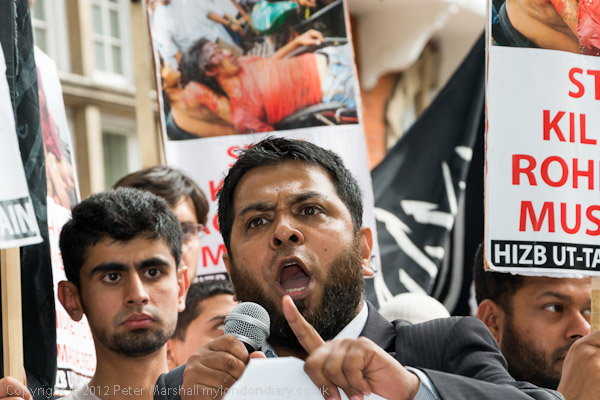
Hizb ut-Tahrir Supports Rohingya, 2012
Although I often share the concerns of Hizb ut-Tahrir which they express in protests – as in this case over the terrible oppression of the Rohingya people in Burma, caught up in the long-running dispute between Burma and neighbouring Bangladesh, with its origins going back into the British rule of India (more on this – and more pictures – in Hizb ut-Tahrir Supports Rohingya on My London Diary), like that journalist I talked to I find the movement disturbing. It seems to represents an extremism which I find chilling, just as I do that of the extremist Christian and political groups I’ve photographed. But unlike many extremist groups, Hizb ut-Tahrir welcome media attention and are always attentive (sometimes perhaps a little too attentive) to journalists and photographers. I don’t think they should be banned but I do wish that more mainstream and moderate Muslim organisations were more vocal both about them and the wider issues that they address.
________________________________________________________
My London Diary : Buildings of London : River Lea/Lee Valley : London’s Industrial Heritage
All photographs on this and my other sites, unless otherwise stated are by Peter Marshall and are available for reproduction or can be bought as prints.
To order prints or reproduce images
________________________________________________________